Planning your next adventure in the heart of the Alps? The Best Hiking Tours in Switzerland 2025 & 2026 promise unforgettable experiences for every traveler, from first-time walkers to seasoned trekkers. With its breathtaking landscapes, efficient transport, and diverse trail options, Switzerland remains a top destination for outdoor lovers.
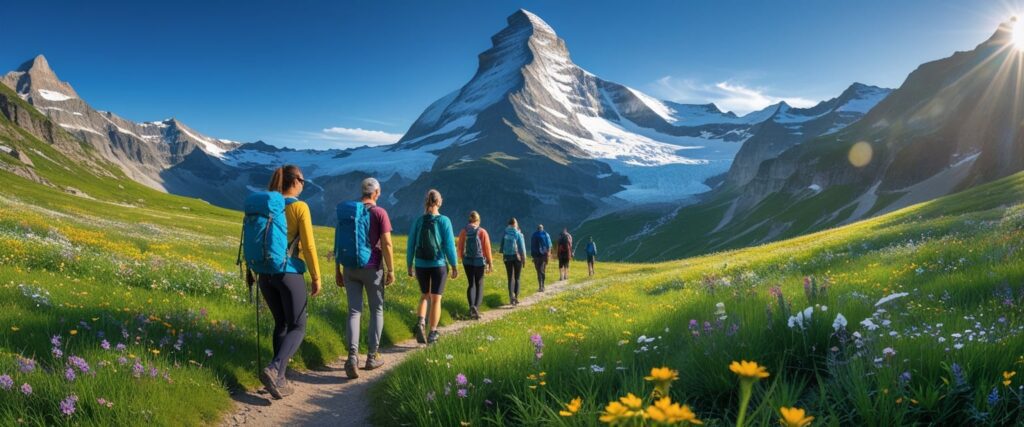
Whether you dream of conquering the iconic Haute Route, exploring the Matterhorn region, or enjoying gentle family-friendly paths, the Best Hiking Tours in Switzerland 2025 & 2026 offer something for everyone. From luxury guided tours to easy walking holidays, this guide highlights the most exciting routes, seasonal tips, and expert advice to help you make the most of your Swiss Alps hiking holiday.
Best Hiking Tours in Switzerland 2025 & 2026
Switzerland offers some of the most accessible and rewarding hiking experiences in Europe. With well-marked trails, efficient transport connections, and routes for every fitness level, it is easy to plan a trip that balances adventure with comfort. The best hiking tours in Switzerland for 2025 and 2026 combine guided treks in the Swiss Alps, easy walking holidays, and family-friendly paths that suit both beginners and experienced hikers.
From the car-free village of Zermatt to the waterfalls of Lauterbrunnen, guided tours showcase iconic landscapes while providing local knowledge and support. Those who prefer a slower pace can enjoy walking holidays around lakes and meadows, while families often choose shorter trails designed with children in mind.

For travelers seeking more challenge, multi-day treks across alpine passes and high-altitude routes remain a highlight. Seasonal options also matter, with summer hikes offering green valleys and winter trails providing snow-covered scenery. This guide explores the top tours, easy walking options, seasonal routes, and essential tips to help make the most of a Swiss Alps hiking holiday.
Top 10 Guided Hiking Tours in the Swiss Alps
Guided hiking tours in Switzerland highlight world-famous peaks, historic alpine routes, and comfortable accommodations. Travelers can choose between challenging treks across glaciers, scenic valley walks, or luxury tours with premium lodging and regional cuisine.
Iconic Matterhorn and Monte Rosa Treks
The Matterhorn and Monte Rosa area offers some of the most recognized trails in Switzerland. Guided tours often begin in Zermatt, where hikers enjoy views of the Matterhorn’s sharp summit and the surrounding glaciers.
These treks usually include routes around Monte Rosa, the second-highest mountain in the Alps. Distances vary, but most tours feature daily hikes of 6–10 miles with moderate elevation gain.
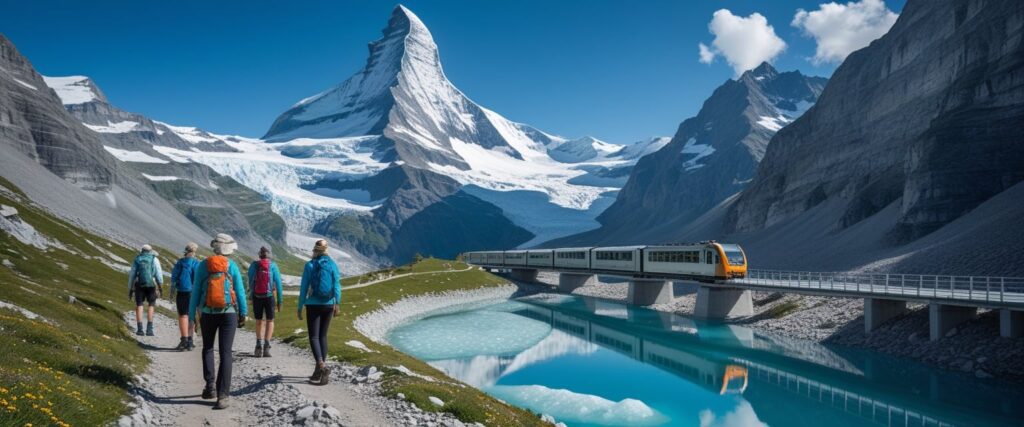
Hikers can expect alpine lakes, suspension bridges, and glacier viewpoints along the way. Many guided Switzerland hiking tours in this region also include train rides through the Alps, making travel between stages easier and more scenic.
Accommodation ranges from mountain inns to comfortable hotels in Zermatt. This balance of rugged terrain and accessible lodging makes the Matterhorn and Monte Rosa treks appealing to both experienced hikers and strong beginners.
Exploring the Bernese Oberland and Jungfrau Region
The Bernese Oberland is known for its dramatic scenery, including the Eiger, Mönch, and Jungfrau peaks. Guided tours here often start from Grindelwald or Lauterbrunnen, connecting hikers to trails with waterfalls, alpine meadows, and glacier views.
The Jungfrau region offers both family-friendly paths and more demanding routes with elevation gains of up to 3,000 feet. Travelers can expect moderate distances of 5–9 miles per day, often with cable car or train transfers to higher trailheads.
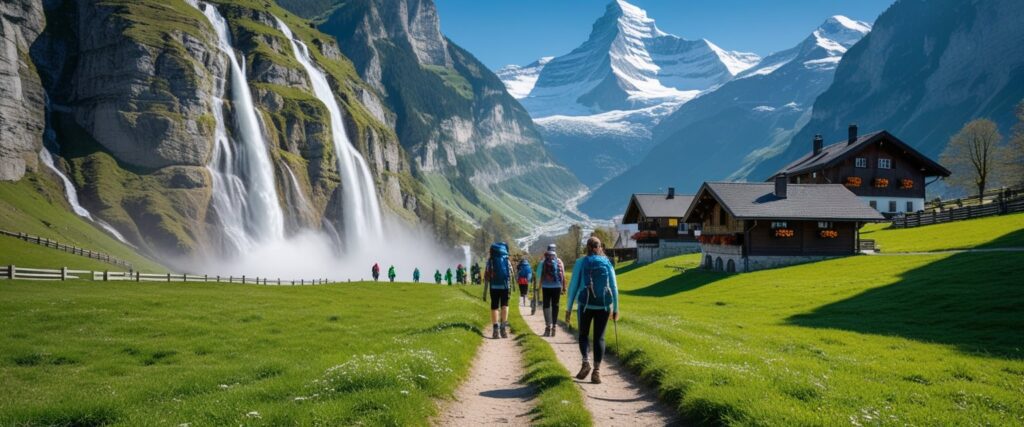
Many guided hiking tours in this region focus on inn-to-inn walking, where luggage is transferred while hikers carry only daypacks. This makes the experience less strenuous while still covering challenging terrain.
The area’s mix of valleys, villages, and high alpine passes provides a wide range of options. It is one of the most popular destinations for first-time visitors to the Swiss Alps.
Classic Haute Route: Chamonix to Zermatt
The Haute Route connects Chamonix, near Mont Blanc, to Zermatt, home of the Matterhorn. This multi-day trek is one of the most famous in the Alps and usually takes 8–12 days to complete.
Guided tours along the Haute Route cover about 100 miles, with daily distances of 8–12 miles. Elevation changes are significant, often requiring hikers to climb or descend more than 3,000 feet in a single day.
The route passes through glaciers, alpine passes, and remote valleys. Lodging varies from mountain huts to comfortable village hotels, depending on the itinerary.
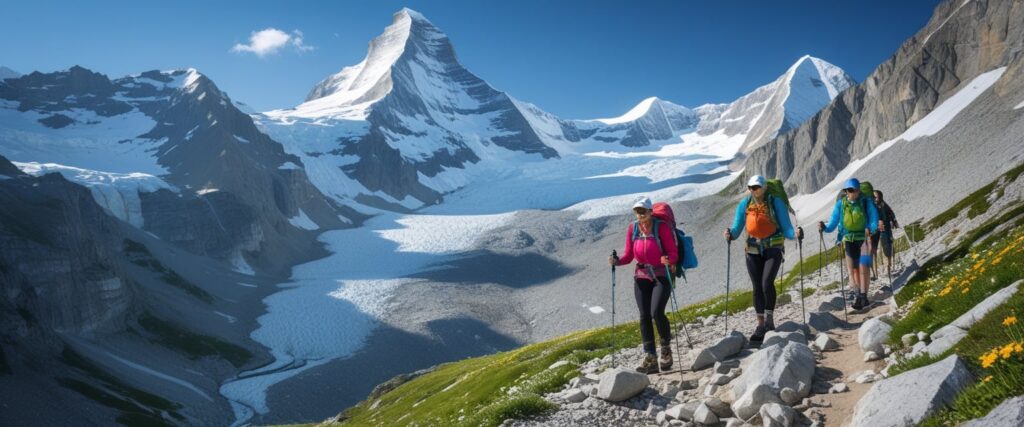
Because of its difficulty, most hikers choose a guided tour to handle logistics and navigation. The Haute Route is considered a top choice for those seeking a demanding but rewarding trek through the heart of the Alps.
Best Luxury Tours and Premium Experiences
For travelers who want comfort alongside alpine scenery, Switzerland offers luxury hiking tours. These trips include premium hotels, spa access, and fine dining while still featuring daily guided hikes.
Regions such as the Bernese Oberland, Zermatt, and St. Moritz are common bases for these tours. Hikes are moderate in length, often 4–7 miles, allowing more time to enjoy cultural experiences and regional cuisine.
Some luxury tours also include private guides, flexible itineraries, and scenic train rides such as the Glacier Express. This makes them well-suited for couples, families, or small groups who prefer a balance of activity and relaxation.
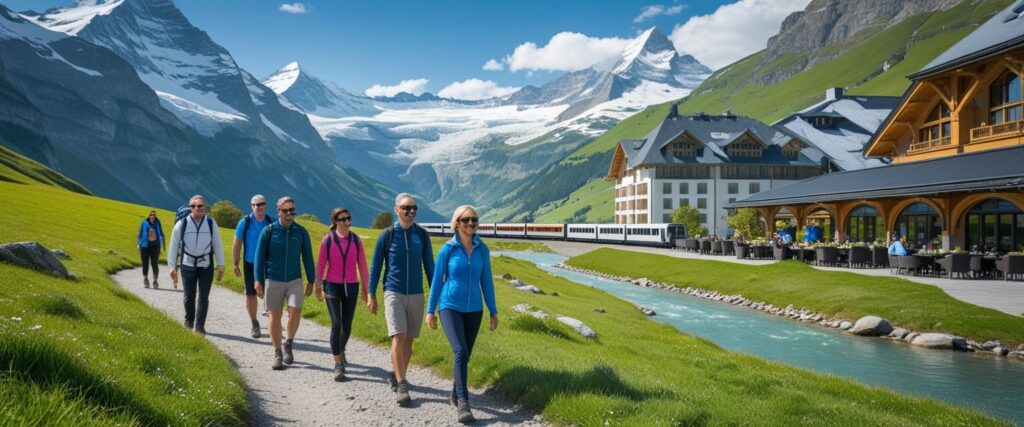
These tours provide access to iconic peaks like the Matterhorn and Jungfrau without requiring long or strenuous days. They combine the best of Swiss hospitality with the beauty of the Alps.
Easy Walking Holidays and Family-Friendly Paths
Switzerland offers many routes that suit families, beginners, and those who prefer gentle terrain. Areas like Appenzell, Saas Fee, and the Jungfrau Region focus on well-marked trails, short walking times, and added features such as playgrounds and activity stations that keep the experience enjoyable.
Gentle Trails in Appenzell and Saas Fee
Appenzell provides easy access to scenic routes with alpine meadows, rolling hills, and cultural landmarks. Trails often include family-friendly stops such as alpine playgrounds and small restaurants that serve local cheese and baked goods. The region’s paths are designed to be manageable while still offering strong views of the surrounding peaks.
Saas Fee, located in the Valais, combines gentle hikes with glacier views and interactive features. Families can enjoy short walks that lead to alpine playgrounds, sensory trails, and scooter runs. A highlight is the panorama trail above Saas Fee, which includes optional cliff walks and suspension bridges for those seeking a mild challenge.
Quick comparison:
| Region | Trail Lengths | Highlights | Family Features |
|---|---|---|---|
| Appenzell | 2–6 km | Meadows, villages, local farms | Playgrounds, eateries |
| Saas Fee | 1–5 km | Glacier views, alpine lakes | Play areas, scooters |
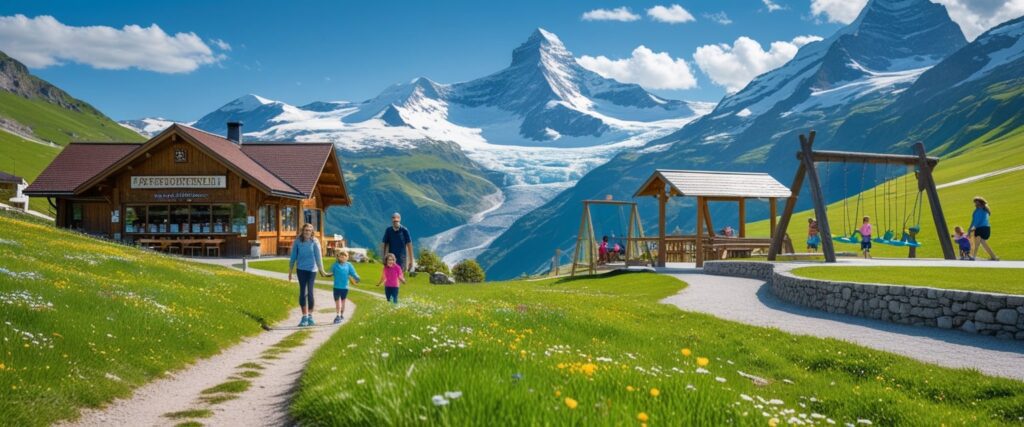
Best Routes for Beginners and Leisure Walkers
Beginners benefit from trails that are short, clearly marked, and close to transport links. In Switzerland, many gondolas and funiculars take walkers directly to scenic viewpoints, reducing steep climbs. This makes it possible to enjoy alpine scenery without needing advanced fitness.
Popular beginner-friendly routes include paths around alpine lakes in Lucerne and the ridge trails near Zurich. These walks often combine gentle grades with extras like zip lines or picnic areas. For those new to hiking in Switzerland, easy walking holidays give a structured way to explore without long distances or heavy climbs.
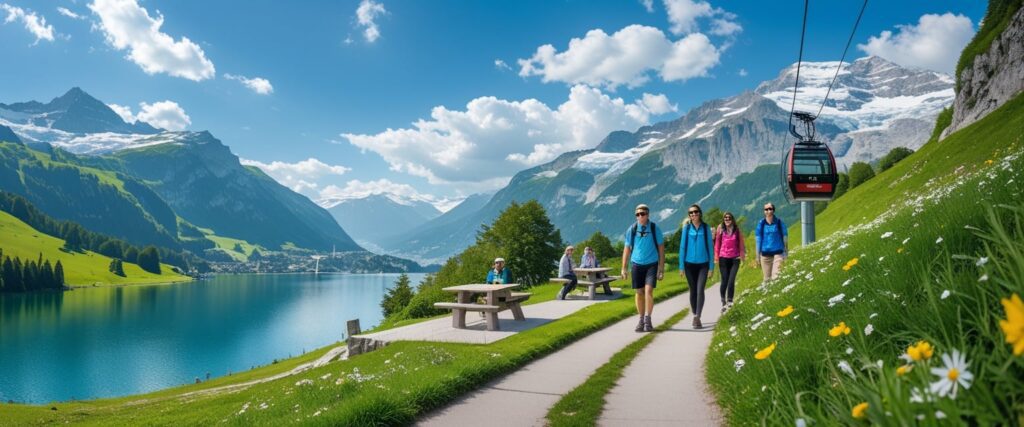
Many of these routes are also stroller-accessible, making them practical for families with young children. Clear signage and frequent rest stops add to the comfort.
Walking in the Jungfrau Region with Kids
The Jungfrau Region stands out for its themed trails designed to keep children engaged. Routes often feature marble runs, dwarf-themed play stations, and interactive activity boards. These short paths, usually 2–4 km, allow families to combine hiking with play.
One example is the Hasliberg dwarf trail, where kids follow a storybook theme through forests and meadows. Another is the marble run trail near Grindelwald, which mixes mountain views with hands-on activities.
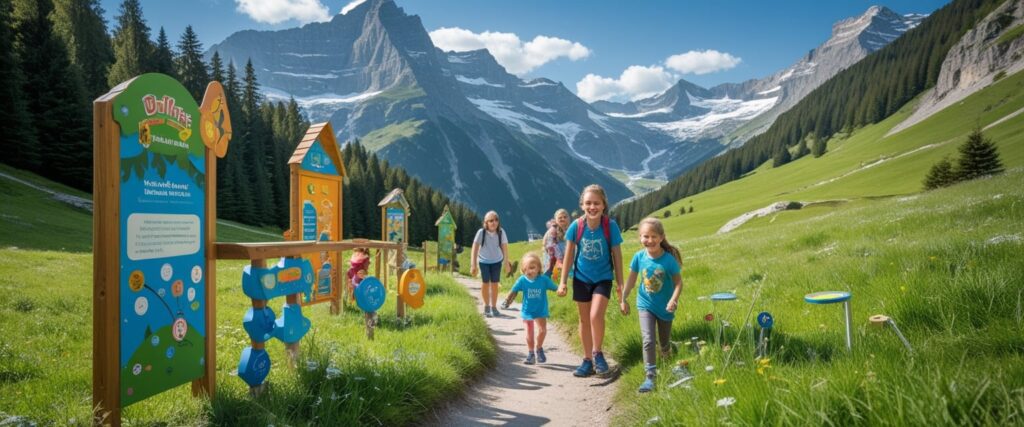
Families also benefit from easy access via gondolas and trains. Many trails in this region end at alpine playgrounds or restaurants, which makes planning a full day trip simple. More details on family-focused walking paths can be found in the best family hikes in Switzerland.
Swiss Alps Trekking: Top Summer and Winter Trails
Switzerland offers varied trekking experiences, from alpine hiking routes in the Bernese Oberland to snowshoe trails near the Matterhorn. Each season brings its own opportunities, with summer opening high mountain passes and winter providing access to quiet snow-covered valleys.
Best Summer Hiking Routes in Switzerland
Summer is the prime season for long-distance alpine hiking. Trails are clear of snow, wildflowers are in bloom, and public transport links make it easy to reach remote valleys.
One of the most famous routes is the Haute Route, which connects Chamonix to Zermatt. This trek takes about 12 days and passes near iconic peaks like the Matterhorn and Mont Blanc. For shorter hikes, the Eiger Trail below the north face of the Eiger offers a 6 km route with dramatic views of glaciers and cliffs.
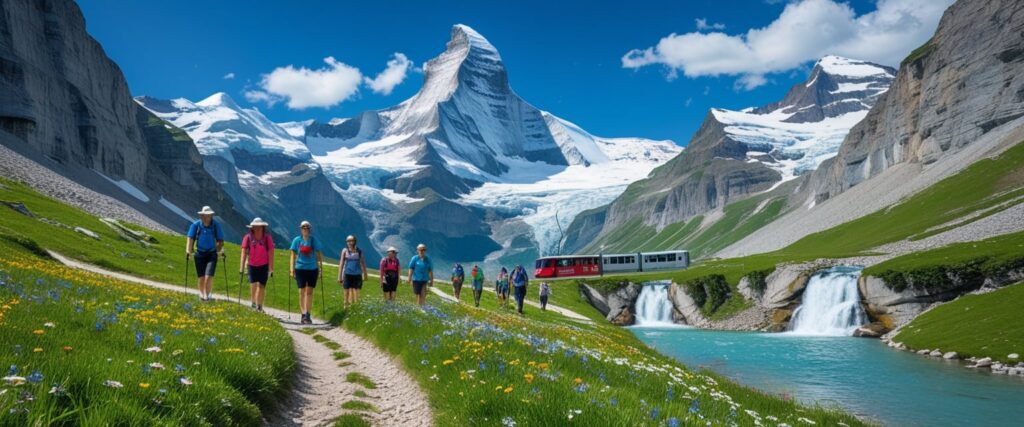
Families and beginners often choose the Lauterbrunnen Valley paths, where waterfalls and meadows provide easier walking conditions. Another popular choice is the Via Alpina, a long-distance trail crossing Switzerland east to west. Many hikers complete only sections of it, especially the Bernese Oberland portion near Grindelwald and the Jungfrau.
For those seeking ideas, top Swiss Alps trekking routes include both multi-day adventures and short scenic walks.
Winter Snowshoeing and Alpine Hiking Adventures
Winter in the Swiss Alps is dominated by skiing, but snowshoeing and winter hiking are growing in popularity. Lower-altitude trails remain open, offering safe routes through forests and valleys.
In regions like Grindelwald and Zermatt, marked snowshoe circuits provide 2–4 hour treks on packed snow. These trails are usually well signposted and avoid avalanche zones. Popular routes include the Panorama Trail above Grindelwald and paths around Gornergrat near the Matterhorn.
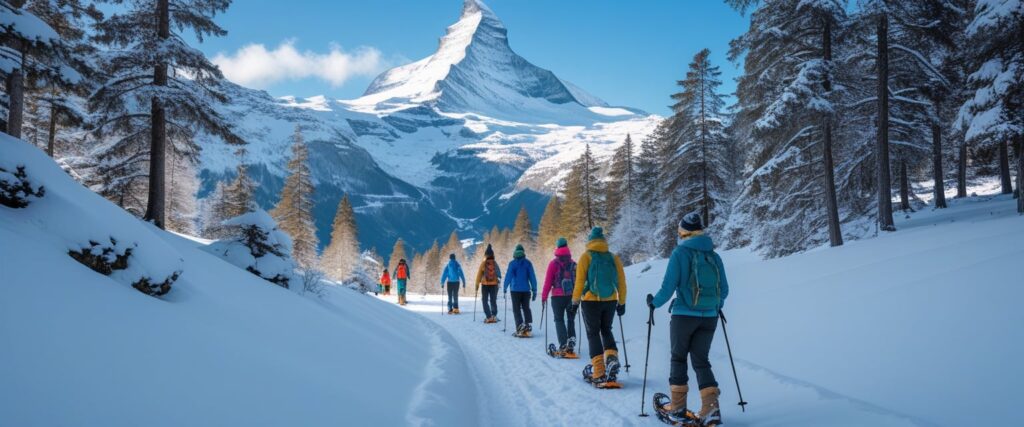
Some alpine resorts also maintain winter walking paths, which are groomed trails suitable for sturdy boots. These routes allow non-skiers to enjoy the mountain scenery without technical gear. Guided Switzerland hiking tours often combine snowshoeing with cultural experiences, such as visiting alpine villages or staying in mountain huts.
Seasonal Highlights: When to Go
Timing is important for trekking in Switzerland. June to September is best for high alpine hiking, as most mountain passes are free of snow. July and August bring the warmest weather but also more visitors.
October offers quieter trails with autumn colors, especially in the Bernese Oberland near Mürren and Wengen. Snow usually begins to cover higher routes by late autumn.
December to March is the winter hiking season. Snowshoeing and low-altitude walks are possible, but high trails remain closed. April and May are transitional months, when lower valleys bloom with wildflowers while higher elevations are still snowbound.
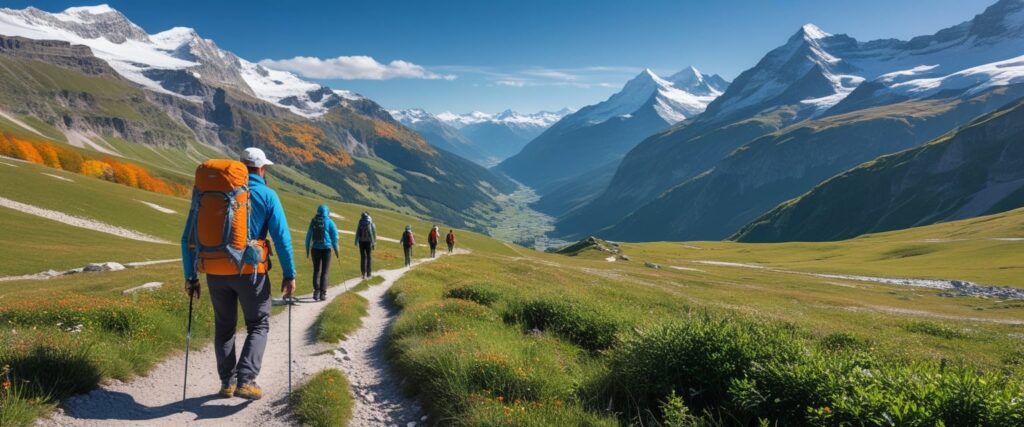
This seasonal cycle ensures that both summer trekkers and winter hikers find suitable trails across the Swiss Alps.
Backpacking in the Swiss Alps: Essential Tips and Planning
Backpacking in the Swiss Alps requires careful preparation, from choosing routes that match fitness levels to packing gear suited for mountain conditions. Hikers should also plan for costs, transportation, and safety measures to make the most of their trip.
Beginner Advice for Multi-Day Treks
First-time backpackers often start with well-marked trails such as the Bernese Oberland or the Five Lakes Walk in Zermatt. These routes are scenic, not overly technical, and have clear signage. Beginners who want support may join a guided hiking tour in Switzerland, which provides structure and reduces planning stress.
The famous Haute Route from Chamonix to Zermatt offers a multi-day challenge. While it is more demanding, hikers can break it into shorter sections or join an organized group. This allows them to experience alpine huts, glaciers, and panoramic summits without carrying heavy loads for the entire distance.
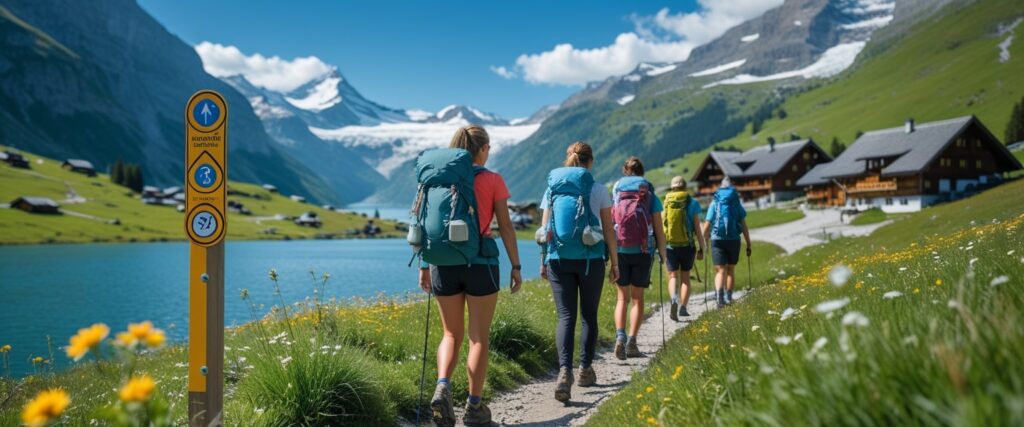
Planning rest days is important. Many Swiss villages along trekking routes have train or cable car access, so hikers can shorten a stage if needed. Beginners should also choose treks with accommodation in huts or inns, which reduces the need to carry camping gear.
Packing and Safety for the Swiss Alps
Weather in the Alps changes quickly. A lightweight rain jacket, insulating layers, and moisture-wicking clothing are essential. Hikers should carry a pack of 10–15 pounds, keeping only the basics:
Essentials to Pack:
- Waterproof jacket and pants
- Sturdy boots with ankle support
- Trekking poles
- First aid kit
- Map or offline GPS
- Snacks and water filter
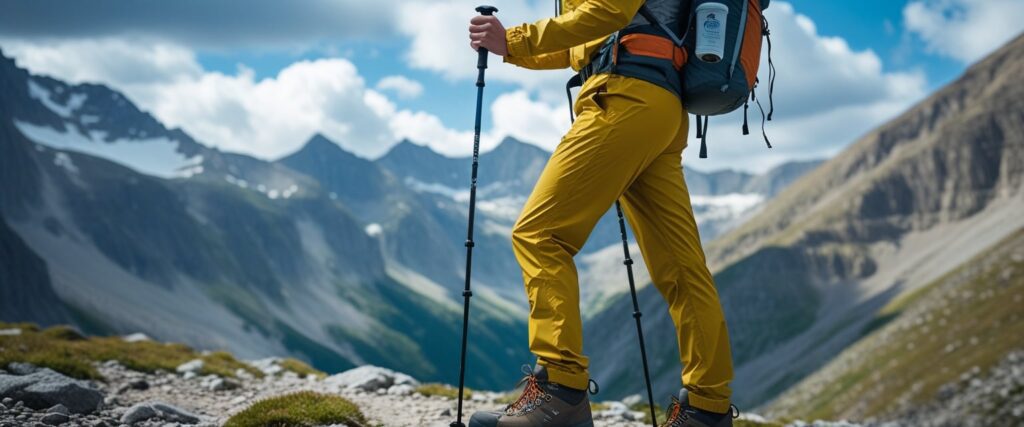
Safety also includes understanding altitude and terrain. Some trails reach over 3,000 meters, so hikers should pace themselves and stay hydrated. On rugged routes, such as parts of the Valais Haute Route, exposure to heights may be moderate. Beginners should avoid snow-covered paths unless traveling with a guide.
Budget and Logistics for Hiking Holidays
Switzerland is expensive, but hikers can manage costs with planning. Staying in mountain huts is cheaper than hotels, and many offer half-board with dinner and breakfast. Booking early is important, especially in summer.
Transport is reliable. The Swiss Travel Pass allows unlimited use of trains, buses, and boats, which helps when connecting trailheads. Scenic rides like the Glacier Express also link popular hiking areas and can be part of the trip.
A typical budget includes:
| Expense Type | Average Cost (per day) | Notes |
|---|---|---|
| Mountain hut stay | CHF 60–90 | Often includes meals |
| Hotel stay | CHF 120–200 | Varies by region |
| Food and snacks | CHF 20–40 | Cheaper at supermarkets |
| Transport pass | CHF 120–150 (3 days) | Covers most routes |
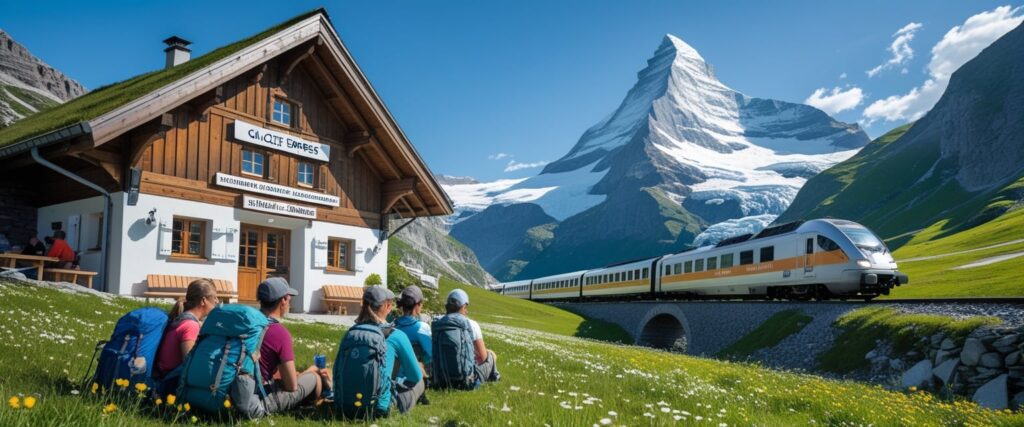
Travelers who want less planning may join an organized Swiss Alps trekking tour. These often include lodging, meals, and logistics, making them a practical option for those new to hiking in Switzerland.
Conclusion
Switzerland continues to stand out as a dream destination for hikers, and the Best Hiking Tours in Switzerland 2025 & 2026 showcase why. From multi-day treks across glaciers to leisurely lakeside walks, these tours combine scenic beauty with comfort, culture, and adventure. Families can enjoy child-friendly trails, beginners can choose easy routes with stunning views, and experienced hikers can challenge themselves with iconic alpine passes.
No matter the season, the Best Hiking Tours in Switzerland 2025 & 2026 provide world-class experiences that blend natural wonders with Swiss efficiency and hospitality. If you’re ready to plan a journey that balances adventure with unforgettable scenery, these tours are the perfect way to explore the Swiss Alps in 2025 and 2026.
Frequently Asked Questions
Travelers planning a hiking trip in Switzerland often want clear details about guided tours, easy routes, family-friendly paths, and seasonal trekking options. Preparation, trail choice, and understanding the terrain help ensure a safe and enjoyable experience in the Swiss Alps.
What are the top 10 guided hiking tours in the Swiss Alps for the 2025/2026 seasons?
Many hikers choose guided tours for expert support and local knowledge. Options include multi-day treks around Mont Blanc, classic routes in Zermatt, and scenic walks near Lucerne and Interlaken. Companies like Active Adventures and Adventure Life offer structured itineraries with varied difficulty levels.
Can you recommend some easy walking holidays in Switzerland suitable for beginners?
Beginners often prefer routes with gentle terrain and shorter daily distances. Popular areas include the Lauterbrunnen Valley, Lake Lucerne, and the paths around Mürren. Self-guided options from providers such as Ryder-Walker make it simple to follow marked trails while enjoying local culture.
What are some essential tips for backpacking in the Swiss Alps for beginners?
Beginners should pack light but include essentials like layered clothing, waterproof gear, and sturdy footwear. Understanding trail signs and weather patterns is important, as conditions can change quickly. Using Switzerland’s reliable train system makes it easier to connect between hiking regions.
Which trails are considered the best for Swiss Alps trekking during summer and winter?
In summer, popular choices include the Haute Route between Chamonix and Zermatt, and trails in the Bernese Oberland. In winter, snowshoe routes near Grindelwald and winter hiking paths around Davos and St. Moritz provide safe options. Seasonal differences determine both accessibility and required equipment.
Where can I find family-friendly walking paths in the Swiss Alps?
Families often enjoy paths with moderate distances, scenic views, and easy access to villages. The car-free village of Wengen and the trails near Arosa are well-suited for children. Many resorts also offer themed walking routes designed for younger hikers.
How do I choose the best hiking trip in Switzerland for both summer and winter?
Travelers should consider fitness level, trip length, and preferred scenery. Summer trips allow access to high alpine passes, while winter options focus on marked snow trails and valley walks. Comparing guided and self-guided itineraries on platforms like Bookmundi helps match the right trip to personal needs.
